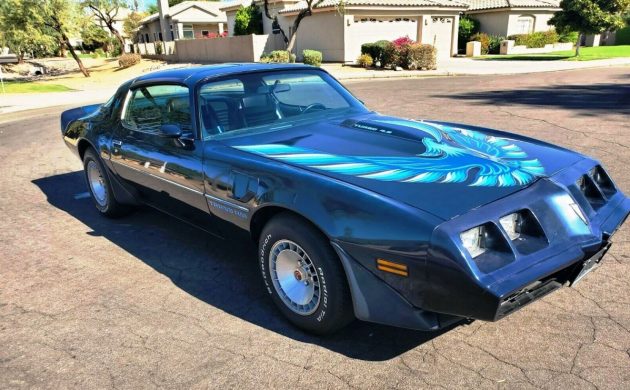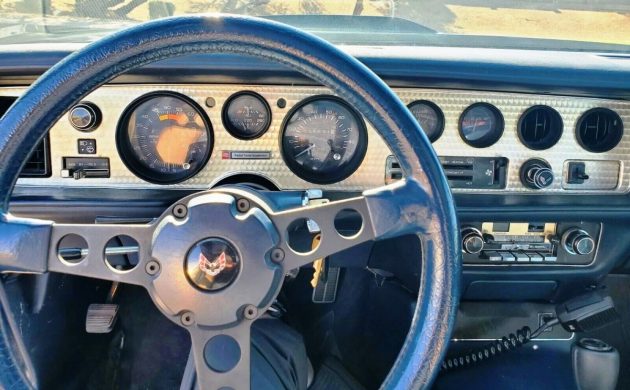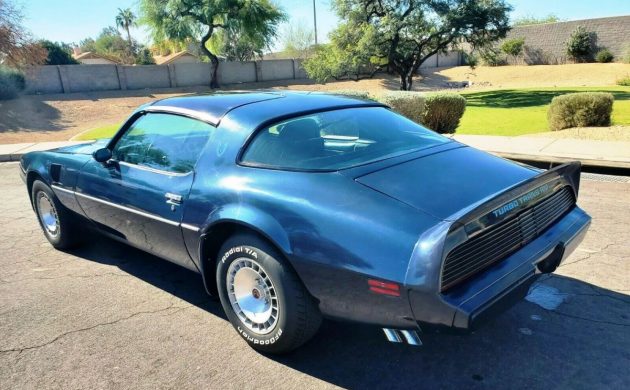During the mid-’70s to mid-’80s, automobile manufacturers struggled to make power with decent fuel economy and reduced emissions. Pontiac took an ambitious step with the Turbo Trans Am. This 1980 Pontiac Trans Am in Scottsdale, Arizona offers a chance to own a fine-looking specimen of high-tech ’80s muscle. The one-owner beauty shows only 54,000 original miles, according to the seller. The listing here on eBay boasts of “many documents,” but none are revealed, and a complete lack of details leaves many questions unanswered. Does it run? Does it retain the model-specific motor and all its unique parts? Serious buyers can prompt the seller to answer the same questions, over and over again, in lieu of providing them here. Let’s assume it’s a legitimate listing and discuss Pontiac’s innovative Turbo Trans Am.
As the owner of an all-blue coupe, this double-blue Pontiac looks great! The engine-turned dash, sport steering wheel, and full instrumentation announce this Trans Am’s sporting intentions for all to see. The CB radio is perfect for practicing your impression of Burt Reynolds aka Bandit.
No engine picture graces the feature car’s listing, so here’s one from OldCarMemories. Today, you can turbo your V8 by watching YouTube videos and ordering Chinese turbos from eBay, but rest assured that Pontiac implemented rigorous engineering in developing this ground-breaking (and fully warrantied) Trans Am. The turbo 301 cid (4.9L) V8 featured a reinforced block, lower compression, unique carburetor, and even a knock sensor to retard timing, protecting the motor from detonation. Forgive yourself for thinking this was America’s first turbocharged V8, but in fact, another GM brand, Oldsmobile, produced a turbocharged 3.5L V8 in the 1962-63 JetFire! Thanks to AutomobileMag for some details.
The turbine wheels and T-tops fly the ’80s flag high. In a year when Chevrolet’s flagship Corvette topped out at 190 HP, the 9 PSI Garrett TBO-305 turbocharger helped the Turbo Trans Am build 30 more at 210. If that sounds underwhelming, dial-up some performance parts, but remember to keep the stock equipment in boxes. Among its contemporaries, this Trans Am was hard to beat for in-your-face performance and bragging rights. “Turbo V8” was a mic-drop statement at your local watering hole. Have you driven a turbocharged V8?





These were much slower than their horsepower numbers would suggest. The producers of Smokey and the Bandit II famously had to use nitrous to get their cars to even spin the tires. TTA Performance fortunately can wake them up now though. They built one to 354 horsepower and 511 lbs/ft torque using fairly standard hot rod tricks and 14 psi of boost.
Biggest issue was 87 octane gas and the knock sensor which would tard timing at the hint of detonation…which turbo.engines will do. Other.maladirs such as a 2.73 or 3.08 gear hooked to a 3 speed auto didnt help. Which they will never be Coyote or LS killers thay can be made respectable for their era. In retrospect, the TA Turbo was.on par with the 403 auto cars.
Rick Underseh’s ( Facebook ) 80 Turbo 301 Formula has Run low 12’s in NHRA Stock – Another 80 301 Turbo T/A Won Vegas in NHRA Stock – they have pontential :)
Bandit one .. you out there?
Its the snowman …
I am at the choke and puke and wanted to know if you need anything?
“What were dealing with here is a complete lack of respect for the law.”
The transmission is a auto something right?
Those shift real good for jumping partial bridges…
I had a ’63 Jetfire back in the day and I used to get ticked off when they advertised these as the first turbo V8. Just one of the cars I wish hadn’t sold.
They figured people forgot.
They were the first American V8 turbocharged production car sold. The Corvair Spyder was the next American turbo charged car, with a flat 6 cylinder air cooled engine. The Corvair continued the turbo engine until 1966.
My favorite feature of the Turbo T/A was the illuminated sequential “Turbo Charge” boost gauge on the back of the hood scoop. My neighbor had one when I was a kid and I always drooled over it walking to school.
The ultimate Trans Am, I love it. No big block can beat these turbos.
I assume you are referring to Pontiac engines… first of all, there is no “big block” or a “small block” Pontiac, they all use basically the same engine blocks. 326-455 are all the same block, other than bore/stroke combinations, some were 4 bolt main blocks, and of course the 455 SD. Sure there are a few minor differences here and there, but they are the same for all practical purposes other than displacement. But regarding “these turbo’s”, again, if you are referencing this car, they were dogs. They gave up over 1.5 seconds and 10 mph in the quarter mile over the standard 1979 6.6 TA. Some here mentioned the 3 lights on the hood, that’s the only indication that the turbo is producing any boost. You certainly can’t feel the “boost”. The 1989 Indy Pace Car Turbo Trans Am, that is a whole different story!
Ugggggghhh…more like “Turdo T/A”.
Actually Buick came out with turbos in 1978 on the LeSabre coupe and Regal, and later the Century coupe had it also. I’m pretty sure these were offered from 1978 – 81 or thereabouts. These were turbo charged 3.8L V6s, so that’s not a V8 – but it’s still a significant contribution from a GM division that most people wouldn’t expect that technological advancement to come from. The turbocharged Olds 215 V8 of 1962-63 is mentioned. That is an engine, in non-turbo form, that GM should have kept and not sold to Land Rover! Technically it was a Buick engine, Olds just added different heads and added the turbo. Maybe it was not a big enough engine for the 1964 models, but it was a success in terms of it being a small V8 with a lot of power, with an all aluminum block and heads that lasted as long as a cast iron engine. They learned how to build an aluminum engine properly, with steel cylinder sleeves. Why they didn’t use what they learned when they came out with the Vega engine in 1970, I don’t understand.
My oldest brothers buddy had one when it was new. I was so excited to get a ride in it one day. I asked him “how do you know when the turbo kicks in?” He floored it and pointed to the three lights on the the back or the hood scoop and said “when one in the right comes on.” Good thing the told me that because you would have never known otherwise. I felt so jipped … like a dog that thinks it’s going to the park and you pull into the veterinarians parking lot.
Decent looking vehicle they are heavy in weight and low in HP it would be a nice ride for a 16 year old girl!
Call me a heretic, but I didn’t like the 77 or 78 Trans Am Pontiacs.
The 79 and 80 models were a better looking car.
The Vega had Sintered iron coated cylinders, not liners, and ironically that wasn’t the major problem with Vegas. Moto Guzzi chrome plated their cylinders on their bike engines. Today many engines have Nikisil treated cylinders and it lasts as long as iron and transfers heat better. Iron sleeves in aluminum blocks don’t transfer as well as other processes. More heat,
shorter engine life.
In 1964 Buick Had a Wildcat they experimented with on the streets of Flint with a twin turbo nailhead that was deemed too fast for the public.
I’d bet that most people who bought these didn’t care so much about the performance as they did when they were getting out of it in a crowded parking lot.
A “full timer” had one of these in this exact color when I had my first job working at a supermarket. Very sharp looking car. Meanwhile, we were driving our rusty, boned out Barracudas, SS’s, and Camaros that could have driven circles around this. But, it was one sharp looking car.